The last month was an intense learning experience spent completing the Siddhi Yoga Teacher Training Certification. It became clear early on that to get the most out of the programme I would need to fully immerse myself physically, mentally and socially. Free time was sparse which meant the blog took a back seat, but what a month it turned out to be.
The teaching began at 7:00 am Monday to Saturday, finishing at 7:00 pm Monday to Friday, and at 1:00 pm on Saturdays. Breakfast, lunch and dinner were provided Monday to Friday, which meant following the evening meal there was little time (or energy) left for much more than sleeping.
Each day began with two hours of Yoga before breakfast and a further hour and a half at 4 pm in the afternoon. The rest of the time was spent learning about Yogic philosophy, anatomy, teaching methodology, adjustments and meditation.
The physical practice of asanas (postures) are only one of eight limbs that comprise ‘Yoga’, and it was during the philosophy lessons we learned about the other seven; Yama (social conduct), Niyama (personal conduct), Pranyama (control of breath), Pratyahara (withdrawal of the senses), Dharana (one pointed concentration), Dhyana (meditation), Samadhi (bliss, joy, enlightenment). There are no stones left unturned.
Yoga means ‘union’ – the bringing together of body, mind and soul. The purpose of Yoga is to facilitate the process of self-realisation; Yoga is both the journey and the destination, the union of the self-consciousness with universal consciousness. It is a road map of principles and practices to follow, each complimenting the other, and necessary to progress towards Samadhi; bliss, joy, enlightenment. As such, Yoga is so much more than a series of postures; it is a way of life.
We were encouraged to follow all eight limbs diligently throughout the month. Because each limb compliments the others, our progress in becoming practitioners and teachers would be enhanced by living the Yogic life, which included eating a vegetarian diet, limiting stimulants like tea, coffee, spices, abstaining from consuming intoxicants and from having sex willy-nilly – meaningful sex with a life partner was allowed.
Staying physically and mentally clean; having a shower in the morning and evening was fairly straight forward, the internal cleansing processes were less so, more on them later. Maintaining a clean mind was especially challenging. In essence, our thoughts represent our intentions, some of which then lead to actions. In Yogic philosophy, however, even our thoughts count towards the balance of good and bad doing in our lives, our karma. Which all stems from the universal law of cause and effect; every action has an equal and opposite reaction. Our thoughts are counted as actions in that equation, and from my experience there is truth in it; focusing your mind (thinking) positively improves bodily functions, reduces stress and leads to better decisions and actions. Focusing your mind negatively has the reverse effect. Eradicating your mind of all negative thoughts towards yourself and others, regardless of the circumstances, however, is no small task.
So how did I get on?
Overall, absolutely fantastic.
The course began with an opening ceremony which involved wearing white clothes, meeting the instructors and fellow students, and a very smoky ritual, which was conducted in Hindi. Without a formal introduction or commentary the ritual, and the people conducting it, were a mystery. Only after the ceremony was over did we congregate in the Yoga studio for introductions of the teachers and students.
After spending so much time on my own, and after awkwardly re-engaging the social functions of my brain, being part of an amazing group of like-minded people made the month a truly rewarding and transformative experience.
It was an international group with participants travelling from Australia, New Zealand, Austria, Germany, France, Hungary, Israel, England, Ireland, USA, Chile, Canada, Italy, Switzerland, Belgium, Mauritias and Turkey. The group contained artists, teachers of French, English, Surfing, Palates, Capoeira, an investment banker, performers of song, musical instruments and dance, a stand-up comedian, a music therapist, a strength and conditioning coach, farmers, a medical doctor, and massage therapists. There were also a high percentage of people living without a fixed abode, practicing their skills while travelling, or in the process of transitioning between careers or countries.
As you might imagine, this mixture of cultures and skills combined with the common interests of learning, practicing and teaching Yoga made for an incredibly stimulating, entertaining and supportive environment in which to bond, learn and grow. It was a real pleasure to spend time with such an interesting group of people living life on their own terms.
The intensity of the training pushed us all to our limits and often beyond. If not for the kindness, support, and encouragement of everyone involved, it would have been a far less transformative experience for all.
During the first two hours of Yoga I wondered what on earth I had gotten myself into. Nine months hunched over Shurly Anne for the best part of eight thousand miles appeared to be rather poor preparation for the body. Working through the various asanas, I looked around the room baffled to see supple bodies contorting into graceful shapes that looked entirely unattainable to my board-like limbs. What I lacked in flexibility I hoped to make up for in determination.
As the days passed by my body began to hurt in places I didn’t know existed. Gradually it began to open up and by the end of the course there were noticeable changes to my posture. In particular my shoulders now sit farther back and lower, and my chest is more open than before. My legs were noticeably smaller and I shrunk a bit everywhere else. I also lost five kilograms despite consuming an unhealthy amount of ice cream and Bhagsu cake, a delicious and addictive local sweet. Obviously not part of the Yogic diet but with so much will-power being exerted on a daily basis something had to give at the weekends!
Yoga is a hands on physical pursuit and many of the asanas expose more about your body than you may want to share, but there is nowhere to hide – together we became more intimately acquainted than we would have had we been studying knitting for example (although knitting was surprisingly a pastime for Kristine, Emel and Lara).
In addition to the Yoga, each evening ended with one and a half hours of meditation with Jayo. We started not with the sort of tranquil, sitting with your eyes closed in a dimly lit room repeating a mantra sort of meditation you may be thinking of, no. We started with ‘dancing’ meditation, which as the name suggests, means losing yourself to the music and ‘dancing like no-one is watching.’ Which in a brightly lit room full of complete strangers wearing yoga attire, stone cold sober, was about as far from conducive to ‘dancing like no-one is watching’ as it gets. The idea was to go beyond the stream of thoughts running through your head, thoughts like ‘this is awkward, I feel like a complete plumb, how has it come to this? Make it end, someone shoot me, PLEEEEEASE!’
I reasoned that my struggle to let go was because all learning is state dependent, meaning that to remember something that you previously learnt you need to revisit the same mental state you were in when you created the learning. I learnt how to dance when inebriated, and every subsequent ‘learning’ in gradually worsening states of inebriation. To say I lacked rhythm would be an understatement; I must have looked like I was ‘dancing’ to something else.
As I looked around the room, though, everyone was clearly struggling with the same inhibitions, some more than others, and then there were the extroverts.
Releasing love as part of an evening meditation process – I love you maaaan in a butch manly way of course!
The daily meditations continued along a similarly cringe-worthy theme until at some point, for all of us, the inhibitions just disappeared. This became abundantly clear while during a morning warm-up before Hatha Yoga, we were instructed to run around the room like mental patients, to which we all immediately responded without question. Before a week of ‘dancing’ meditation, ‘shaking’ meditation and inducing anger, sadness and laughter together, it might have seemed like an odd thing to do. The realisation that we had all become separated from our inhibitions spontaneously released hysterical laughter.
This dancing meditation was after the inhibitions had disolved and it seem perfectly natural to dance around together.
Laughter was an unscheduled and ever present part of the daily grind, at times I laughed so hard and uncontrollably, I worried I might not be able to stop. I could think of worse afflictions to fall foul of.
Speaking of falling foul reminds me of the morning we carried out a number of internal purification practices referred to as Shatkarma. The aim of Hatha Yoga and therefore Shatkarma is to create harmony between the two major pranic (energy) flows Ida and Pingala. In doing so, physical and mental purification and balance are attained. There are six Shatkarma (shat means ‘six’ and karma, ‘action’), each encompass several techniques of varying intensity and er.. courage.
We practiced two Neti techniques; cleansing and purification of the nasal passages. The first, Jala Neti, was relatively simple but quite minging, and involved pouring warm salty water in one nostril while tilting your head to one side. The water flows into your nasal cavity and gradually flushes the excess mucus out the other nostril. Repeat on the other side to complete the cleanse, nice.
The second, Sutra Neti, was rather uncomfortable and in the end comical. The aim is to push a rubber hose up your nostril until you are able to pull it out of your mouth from where it has emerged in your throat. Then, by simultaneously pushing and pulling the hose with either hand, your nostril is cleaned, like a pipe. Sounds simple enough, however, pushing the hose up my nose caused spontaneous sneezing, which after a while became very amusing, and messy, very messy.
Next up was Dhauti which comprises a series of internal cleanses separated into three regions; intestinal, head and thoracic. We completed only one practice from this delightful group, Vaman Dhauti, ‘regurgitative cleansing’. We completed the Shatkarma’s in the morning with an empty stomach, then drank glasses of warm salty water as quickly as we could until our stomachs’ were full and we felt physically sick. Then, with the aid of our least favourite hand, pressed the base of our tongues until all of the salty water was vomited back out. It was a good job we had gotten to know each other by then.
Yogesh then demonstrated a more involved version in which he slowly swallowed a thirty foot cotton cloth soaked in salty water. It was pretty uncomfortable viewing as he fought against the body’s natural gag reflex for ten minutes, before regurgitating it back out. There are many more purification practices which wallow along a scale from comfortable to gruesome. I, like most, was pleased to leave it where we did.
Yogesh fighting the bodys gag reflex to swallow a thirty foot cotton cloth soaked in salty water. Hmmm yum.
The process of breaking down physical and mental boundaries together caused bonds and friendships to form which would normally happen over much longer periods of time, if at all. To top it all off we even met the Dalai Lama!!
The day we met the Dalai Lama, an incredible experience. As he approached our group he stopped, bent down, touched Mack’s Knee and said ‘There is something wrong here.’ Mack had dislocated her knee a week earlier during class and was still suffering significant discomfort – The awareness of an enlightened Being in action!
BUT.
The course was far from perfect; some of the scheduling was poorly thought out, many of the student rooms suffered from damp, and despite written assurances that the maximum number of students per class would be no greater than twenty-five, thirty-two students had been enrolled. The Yoga studio really wasn’t big enough to comfortably accommodate thirty-two students, furthermore, there often wasn’t sufficient teaching assistants to ensure everyone received the tuition and feedback they required. The class size further effected the last week of teaching by reducing the number of lessons in order to shoe-horn in all of the practical examinations. The oversize class was a significant gripe for all participants, and, frankly, saying one thing and doing another is incongruent with Yogic philosophy on many levels. It really boiled down to greed. The best teachers are those who walk the talk and in my opinion this was totally unacceptable.
That said, the teachers were a unique and mostly inspiring bunch. Yogesh taught philosophy and Hatha Yoga, and for me was the epitome of what a Yoga teacher should be. With deep knowledge and wisdom, Yogesh was a shining example of a Yogi who walks the talk in every way.
In total we had five different Yoga teachers covering four different yoga styles; Yogesh teaching Hatha, Suzanne teaching Vinyassa, Manu and Mahi teaching Ashtanga and Hari teaching Iyengar. At times, learning four different styles was confusing. There were subtle differences between styles which effect how the asanas were performed. Hatha and Iyenger are performed slower and spend more time holding postures. Iyenger also uses props which included belts, cushions, wooden blocks, foam blocks, chairs, walls, and occasionally a combination of all of the above (to assist the most rigid of students.. ahem).
Vinyassa flows between asanas and, as a result, works up more of a sweat. Ashtanga has gymnastic roots, is the most physically strenuous, and at the higher levels has some of the most athletic and visually impressive asanas. Although confusing to learn, as a practitioner and teacher, understanding multiple styles will be of benefit when offering classes to different groups of people with different goals.
From left to right; Mahi, Christine and Melissa. Christine being adjusted whilst performing wheel pose.
Mahi, one of the company Directors, also taught adjustments, which examined individual asanas with the aim of enabling students to get into, hold, and get out of them safely. Using props where necessary, incredibly, almost all postures were achievable to some degree, for almost everyone. Mahi is a high energy teacher with an ego the size of India, which could be an understatement for a man who wears a t-shirt saying ‘god is busy’ on the front, and ‘Mahi will help you’ on the back. The first Ashtanga class was essentially an exhibition of Mahi’s greatest Yogic asanas, being ‘performed’, while teaching us mere mortals the lesser versions. Honestly, I quite enjoyed seeing what was possible after twenty-six years of practice; however, his focus was on ‘performing’ not teaching. Add in his cringe-worthy habit of telling sexist jokes, and you have a marmite Yogi. What cannot be disputed is his incredible ability to see where adjustments are required to correctly exact an asana. And, his knowledge of how to make the adjustments, with and without props, depending on the physique of the student. Being exposed to that level of knowledge and understanding was a huge benefit which was, on balance, worth the cringing.
Guru Mukh was responsible for the day to day running of the course and taught teaching methodology along with assisting in Yoga classes and guest appearances on the Sitar (Indian Guitar) during student practical exams. Guru Mukh was the go-to man for any problems and did a fantastic job of juggling the wants and needs of thirty-one people for a month (one left early on due to language problems). He was very warm hearted, peaceful and humble throughout, and I only hope his experiences and opinions are valued and acted upon during future trainings.
The last week of the training was predominantly spent in student practical exams either as a student, or a teacher when the time came. We were split in to teams of three, with one team of four, and tasked with teaching an hour and a half of Yoga, to include; Pranyhama (breathing exercises) and Asanas. This made for a pretty physical end to the month, with two classes a day, most ran over to two hours and some ran over to three (Dustin, Rhys)!
The rest of the time in the final week was split between exam preparation, adjustments, philosophy and anatomy. Anatomy was very detailed and, at times, seemed like too much information. Medical terminology is like a foreign language and often the sheer volume of new words with only one specific meaning caused many of them to merge into gobbledygook, never to be untangled and recited the same again. It was during the last few lessons of the very last week that we learnt the relationships between the anatomy and specific asanas. This seemed to be the wrong way round, as we would have benefited far more from understanding the relationship between the anatomical structure and the asanas at the beginning of the course.
Finally, after all practical examinations had been completed, only the written examination stood between us and our Yoga Alliance accredited certificates. We all passed.
I believe the intentions of the team at Siddhi Yoga are good, and that between them they have the foundations to create an outstanding teacher training school. Whether they do or not depends largely on their ability to listen to, and act upon, the feedback they receive from their students.
I would recommend the Siddhi Yoga Teacher Training Program to others, warts and all. It must be viewed as the starting point towards becoming a Yoga teacher, there is so much more to learn than can be absorbed in a month of teacher training. The next step for me is self-study and assisting in Yoga classes.
With my Indian Visa due to run out at the start of July I have begun cycling towards Kathmandu, Nepal, where I have arranged to visit a non-profit Ashram, and two other Yoga teacher training schools with the aim of continuing my practice, assisting and, if possible, teaching.
But first I have enrolled in a ten day Vipasana Meditation, starting on the first of July. More on that, and the journey to Kathmandu, to follow. Better get pedalling….
[This post is soooo late due to problems accessing wi-fi and electricity along with a fairly demanding daily cycling schedule to make the start date of the Vipassana course in Kathmandu. I am now in Kathmandu and have today completed the ten course and will be publishing another couple of blog posts during the next week to bring the blog up to date.]
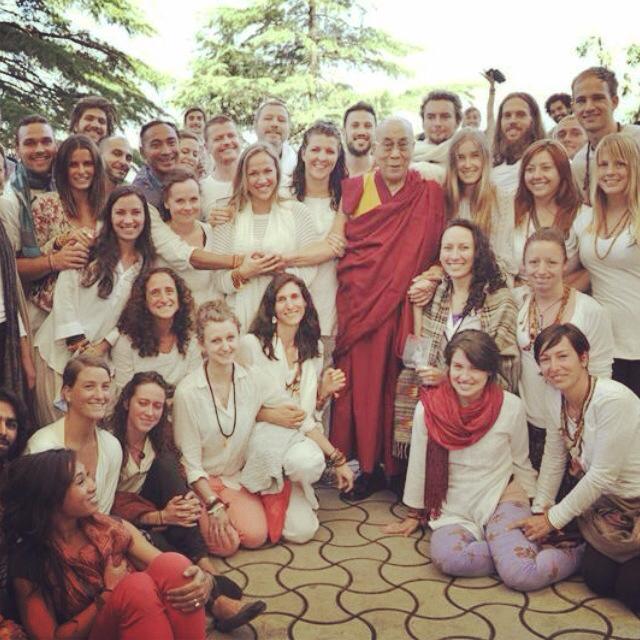
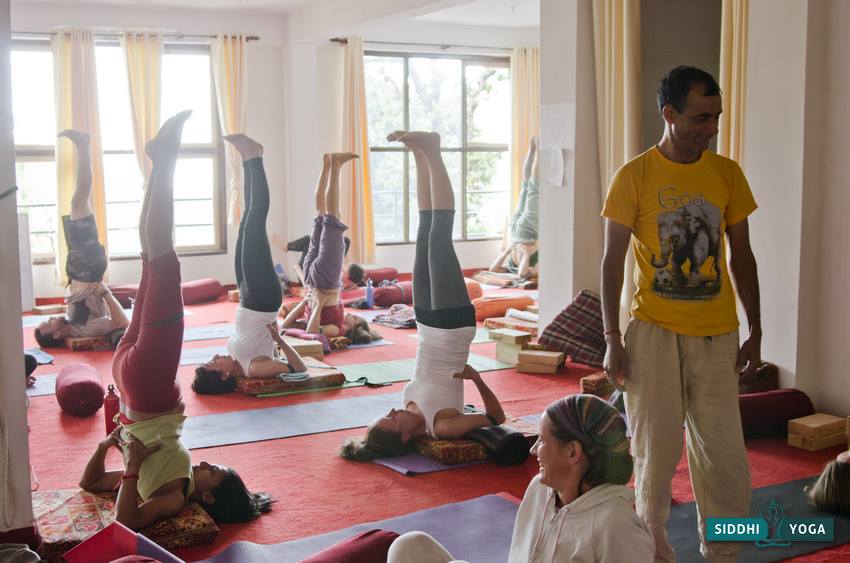

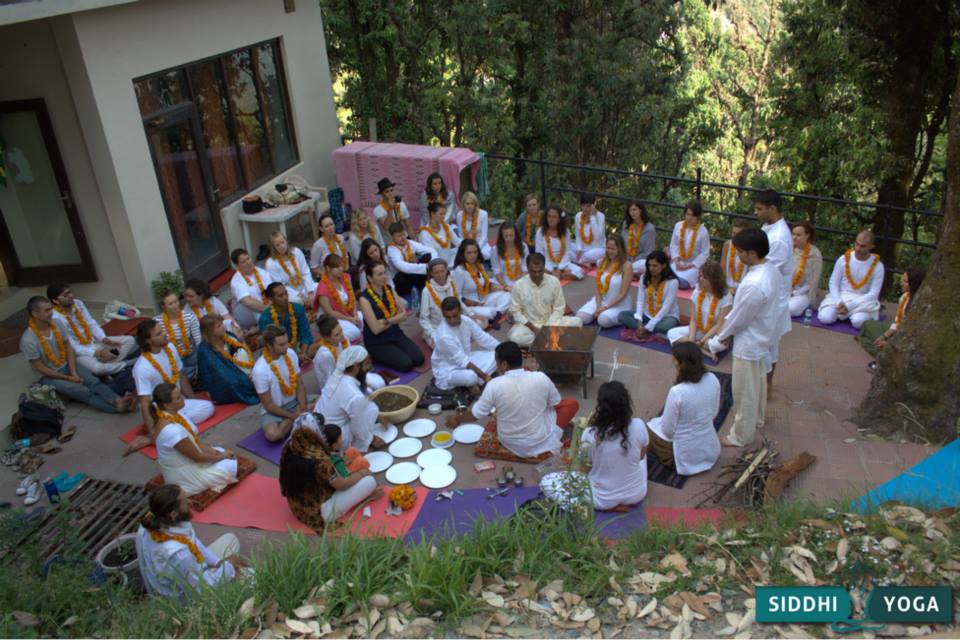

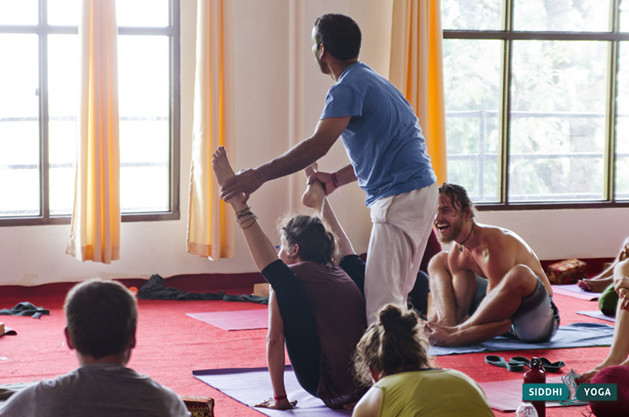
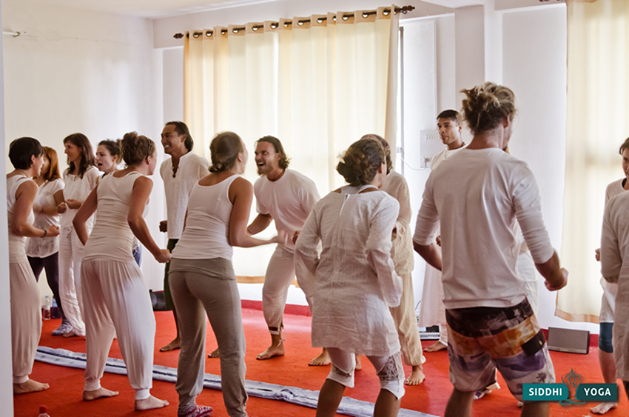
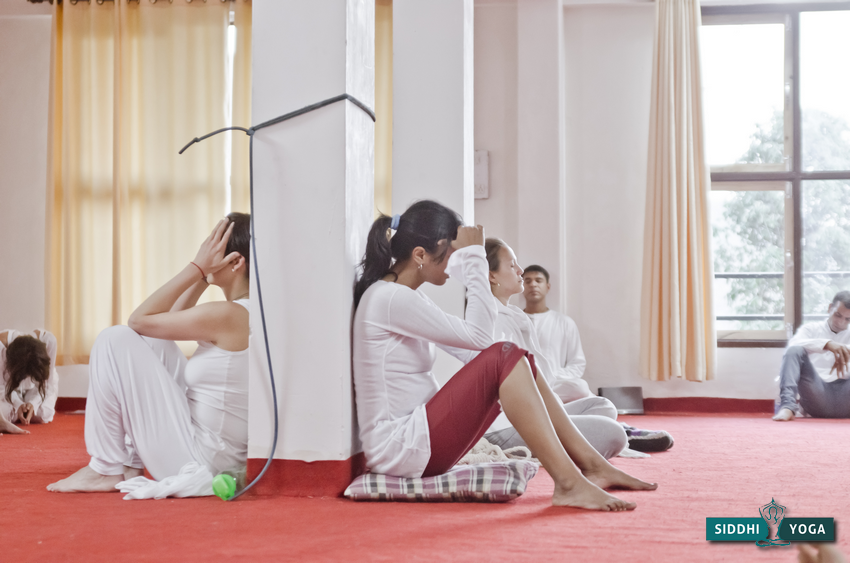
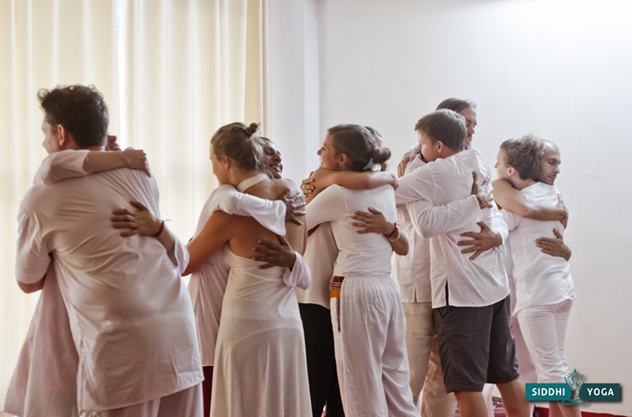
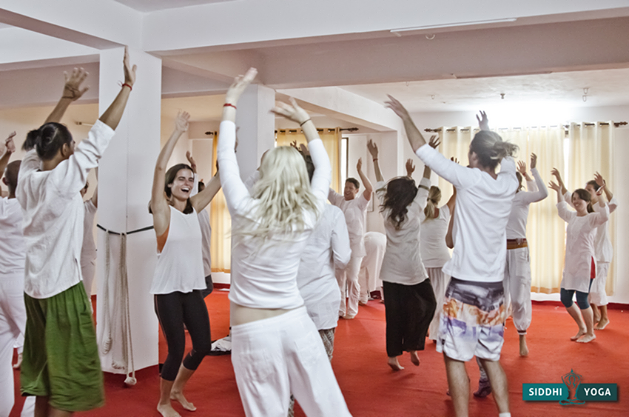
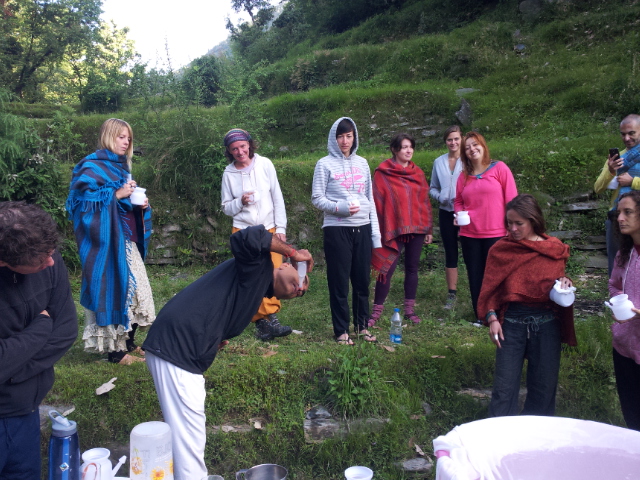
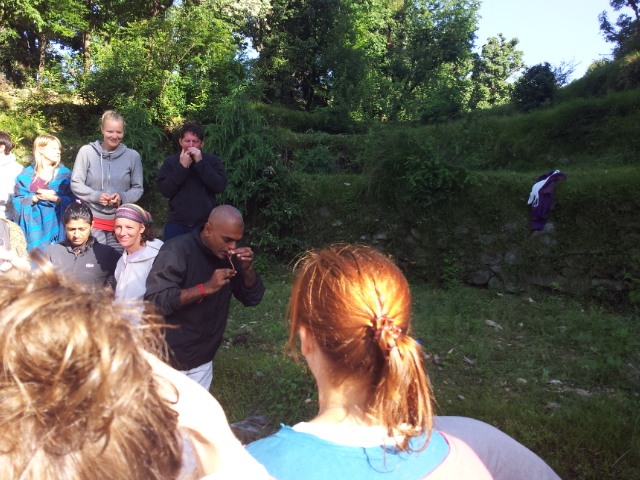




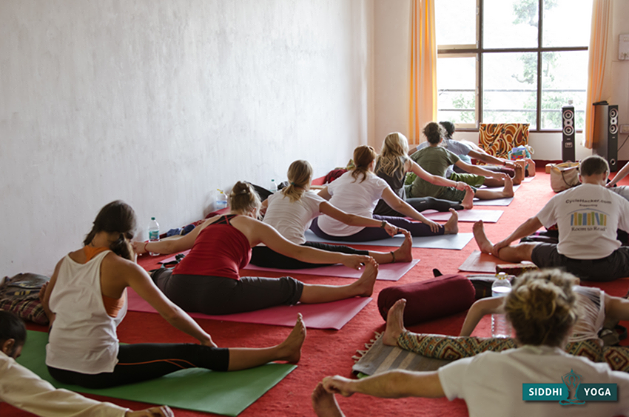
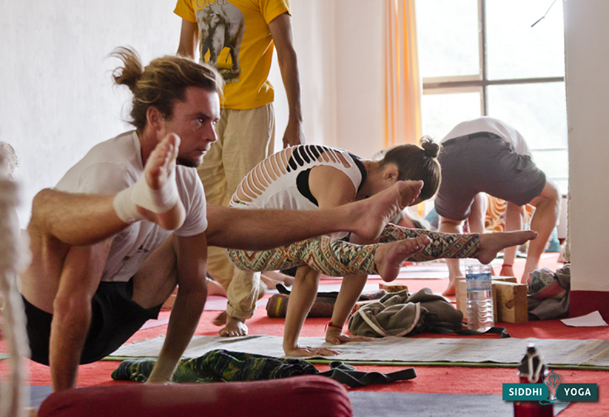
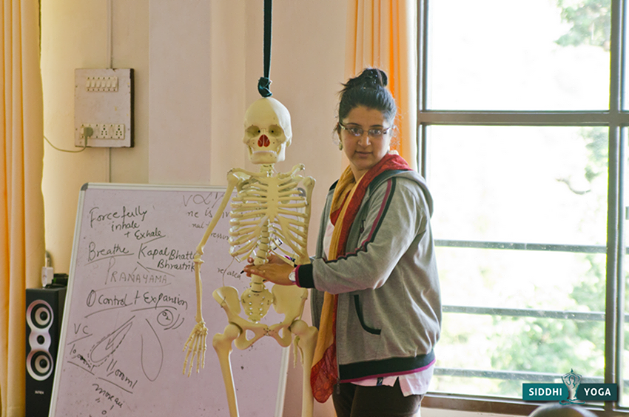
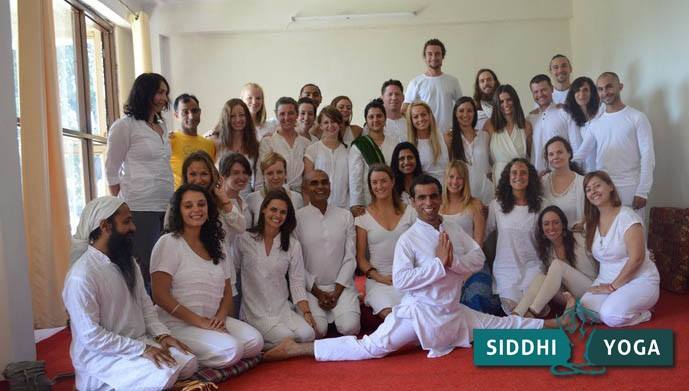
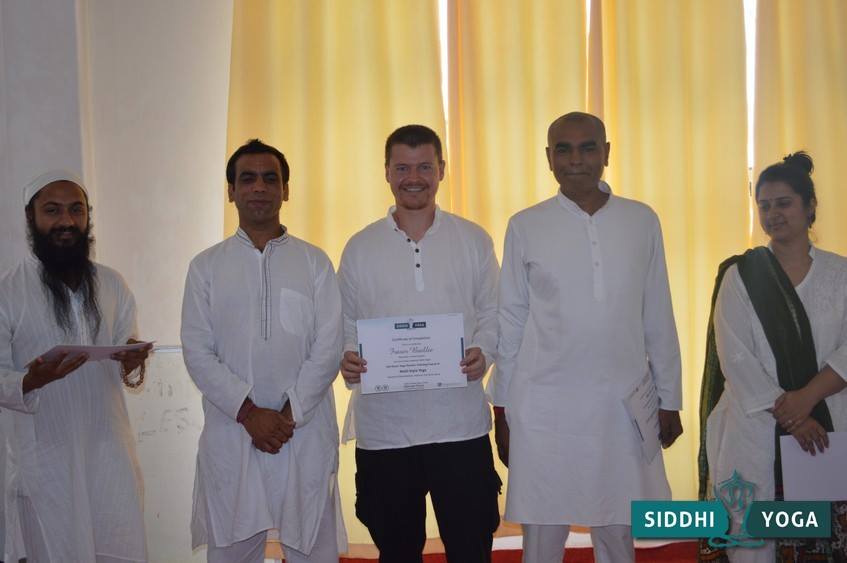
What an amazing experience. Well done you, no mean feat to overcome the cycling asanas!!
Looking forward to hearing more
Love Jane x
Cheers Jane
Dear All . All of us left siddhi yoga coz meera wat husband has chitetd us . We all working in our old school that is http://www.mahipoweryoga.com
I really enjoyed reading about your experience of yoga teacher training. It was a very informative post and I could sense throughout that you have learned a lot and that in spite of the intensity of the course and the pitfalls of the organisation you’ve had a great time.
I hope the other training schools will be just as good if not better 🙂
Hi Anne-Laure,
Lovely to hear from you – the training was a fantastic experience – I now have years of practice ahead of me!!!!
Dear Fraser,
Wow! What a detailed review. Just wanted to let you know that we value feedback and try our best to improve things. There is nothing much we can do now for the training you have already finished. But your valuable feedback will help us improve and grow. Based on the feedback from your batch we have already taken 2nd Yoga Hall in Dharamshala and Goa. Now we are not keeping more than 20-25 students in any yoga session. Whenever there is a big group like yours, we are splitting them into two groups for Yoga Classes. We have also structured the program in such a way so that students can get maximum benefits and still improving it with every feedback. In your batch we were having ex-students as volunteer for adjustments and they disappeared later. Now we have permanent paid adjusters. Mahi is also spending more time with students on each Yoga class of other teachers as well. We have purchased projector as well but still working on creating presentations. We know still there is lot of room for improvement and it will take time. But I assure you that we value each feedback and believe in long term relations. We want to become “Go-To YTT School” in India in coming years. And I am sure as long as we are getting true feedback like this one, we will be able to achieve that.
With Love and Light!
Meera
Hi Meera,
Thank you for your response, I’m pleased to hear the feedback from our group has been valuable and is being used to make your trainings even better.
Namaste!
Hi Fraser,
the Cycle Show was on TV and they were talking about someone’s round the world trip which prompted me to google others who had and found this site.
I hope it’s all going well and you and the bike are bearing up.
Enjoying reading the blog entries.
Regards,
Ed.
Hi Ed,
The bike was in desperate need of some TLC on reaching Kathmandu. A good clean and a service and it is as good as new. Glad you’re enjoying the blog back on the road again soon!
Thank you for this review – I have begun researching training centers in India and found your post. It is great to hear you had a lovely time. I am really thinking about Siddhi Yoga. Thank you again!
Hi Susan,
So pleased the review was helpful – wishing you all the best on your Yoga journey.
Namaste
Hi Fraser, I was looking for testimonials of this Siddhi Yoga Teacher Training and found yours: thank you for your precise review! I am thinking of attending the course next July. Where you in Dharamshala?
Hi Elisabetta, Glad you found it useful and, yes, I was in Dharamsala. You’ll have a great time, good luck!
This seems like such an unbeatable experience. I am highly considering this amazing opportunity. May I ask the cost of this teacher training?
Hi Jackie, sorry for the delay – I think I paid 900EUR but you need to check with Siddhi direct.
Thanks sharing! Looking forward to visit Siddhi yoga!
Dear Fraser ,
Thanks for the information about the course, I’m currently looking to book my yoga course in goa. So I’m hopping that some of the issues that you mentioned are now solve.
Namaste
Maria.
HI Fraser
Thank you for writing such an in depth review. I am currently in the process of researching ytt courses and this has proved to be the most helpful review i have found to date. So much so that it gave me butterflies thinking about when I do mine! Warts and all, this sounds like a great school. Nowhere will be perfect I guess and your review means that Siddhi has now made it in to my top 3 choices! There are so many to choose from, I hope i make the right choice and have an experience as great as yours. 🙂
I hope the rest of your trip was wonderful!
Namaste, Natasha xx
Dear Fraser,
Just wanted to give a quick update as lot of changes happened in last few months. You have already commented above “Mahi is a high energy teacher with an ego the size of India”. That was when we just started with him. As time passed and we had more and more students, his ego increased 100 times more than what you have experienced. On top of that he started introducing ex-students with very less experience as teachers. Due to these reasons last year we have received tremendous amount of complaints from students and we have dropped him along with his complete team from teaching panel. Now with new team we have achieved 100% satisfaction rate since October 2015 and students are extremely happy. We no longer take more than 25 students in any of the center. Location and food has been improved a lot. You may want to take a look at our site and also most welcome to come and try new team and trust me you will not be disappointed at all.
With Love and Light!
Meera
This is a very helpful review… I am considering enrolling in the same school, but still searching for genuine reviews like this.
This honest review is so helpful! Thank you for sharing. I wish you all the best in your yoga journey!
What a great review!
I am looking into the 200 hour training and have read many reviews about the teaching quality at Siddhi.
I’m trying to get a feel for the campus and if you liked how far out of Dharmasala proper it was.
Was it easy to get to town on the weekend? Could I ride my bike?
Hi Caitlin,
The location may have changed best to check with Siddhi for the most up to date info. When I completed the training it was in Bhagsu or Dharamkot, which is a bit further up the hill than Dharamsala. You can find everything you need in McLeod Ganj, which is in between Dharamsala and Bhagsu. I didn’t travel to Dharamsala during the course but did get there by bicycle and can tell you it’s possible but bloody hard work 🙂 Also, had a quick look at the Siddhi website and it looks all of the teacher have changed except Dr Amrita who was ace and taught anatomy and physiology. Yogesh was my favourite teacher and he has set up a new enterprise which you can find out more about here: http://www.yogashivoham.com/, it also looks like Mahi and the other teachers (including Yogesh) are offering courses through: https://www.mahipoweryoga.com/gurus.html. All the best with your Yoga journey.
thanks for the great post with us.
The information given by you is absolutely correct and Honest, Thanks for making this type of honest review.
Your shared correct information with us. Thanks for sharing with us.
Thank you for sharing such a nice information
Hi Fraser, nice article.
https://thaffshop.store
https://www.docracy.com/userprofile/show?userId=0npca2cqcme
примерный ресурс https://casinospinups.com
Hey Fraser, Thanks for sharing very good and very useful information.
Thank you for explaining to us about yoga.
We at Heritage Architects which is Best Architects in Dehradun, are Multi Diciplinary Team of Technically Experienced Professional who can Offer Consultancy in Wide Range of Architectural,Interrior,Structural and Construction Manegement Projects. Our Team Consists of Highly Qualified and Exeprienced Architects, Interior Designers,Engineers and Management.
Bike Rental Dehradun
Bike rides are among the most enjoyable experiences one can have in Uttarakhand. If you’re located in Dehradun and are unsure of where to rent a bicycle and you are looking for a bike rental, then the Uttaranchal Bike Rental is the most suitable option for you in Dehradun. Uttaranchal Bike Rental gives you the most reliable bike rental within Dehradun to enjoy all the streets of Uttarakhand and the nearby states, therefore, we recommend you to stay clear of the crowded buses and other public.
Global Edu Consulting is an educational consultancy situated in the lush green valley of Dehradun. Established over 10 years ago, GEC has made its name as the leading educational consultancy in the state of Uttarakhand. Assisting hundreds of students in getting into their dream institutions. GEC understands the value of high-quality education and consistently works towards providing it to the students. GEC has been working honestly, selflessly, and tirelessly toward providing the right information and options to its students and their parents and eliminating misperceptions. It provides great opportunities and helps in selecting the right institution for a better future.
Under the support and sponsorship of Azad Educational Society, the Himalayan Institute of Pharmacy and Research was set up in 2006 in the serene land of Rajawala Selaqui, Dehradun, Uttarakhand. With the vision to educate and guide the young generations most constructively and innovatively for nation-building, HIPR tries to inculcate a spirit of confidence and self- respect among the students. The institution provides State-of-the-Art facilities and an excellent education system ensuring the overall development of the students. HIPR offers a wide array of courses in the field of Pharmacy, Management, and Agriculture.
Thanks a lot for doing efforts for this useful information.
“Thank you so much for an incredible class! Your classes always nourish me in the most amazing ways. It’s HEALING. I really loved the meditation that you did at the beginning of class… and found it so helpful…
This honest review is so helpful! Thank you for sharing. I wish you all the best in your yoga journey!
https://thegoodschool.org/index.php/SchoolList/filter_school/Delhi
You have excillent quality of writing i must say.
Really love your site always helps me to solve my problems,
cheers!
It’s evident from this insightful blog post that the author has taken the time to carefully assess the Siddhi Yoga Teacher Training Program. The recognition of the team’s positive intentions and foundational elements for creating an outstanding school is commendable. The emphasis on the crucial role of feedback in shaping the program’s success reflects a constructive and forward-thinking perspective.
What sets this review apart is its honesty—acknowledging both the positive aspects and areas that might need improvement. By recommending the program “warts and all,” the author provides a balanced viewpoint, allowing potential students to make informed decisions.
The acknowledgment that a month-long training program is just the starting point towards becoming a yoga teacher adds a realistic touch. This understanding of the journey ahead and the commitment to self-study and assisting in yoga classes showcase a genuine dedication to personal and professional growth.
In conclusion, this blog post serves as a valuable resource for those considering the Siddhi Yoga Teacher Training Program, offering a nuanced and thoughtful perspective that goes beyond surface-level observations. The author’s genuine commitment to ongoing learning and improvement is inspiring and adds credibility to the overall assessment.
Mips Reporting Services In USA https://qppmips.com/